We showered (under running water), we slept (without night-watches and worry), breakfasted late and listened to a Church Service online. At last, we were ready to exercise our land muscles.
We were moored at the Centro Nautica marina situated at the foot of “Old Town” or the “Historic Centre” of Salvador. This is where Salvador’s history started. Old Town lies very high on a cliff where they built it to protect it from invaders.
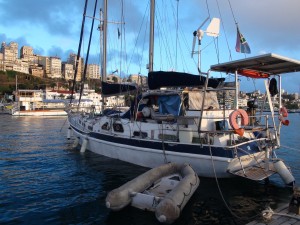
Shang Du in her “reverse” parking at the marina. You can see Old Town on the hill and the Naval Base at sea level.
The only way to reach “Old Town” is by the use of a tall elevator. The Lacerda Elevator looks very modern amongst all the other run-down buildings, but this “new” building was already finished in 1873.
Leaving the marina, we admired the display of colourful sarongs in front of the Mercado Modelo Building. We chose to walk through the Mercado where there is a huge “vlooimark” full of touristy things to buy. Very interesting, but not cheap. The restaurant on the top level (where Adelio took us the previous day) is dedicated to a very famous person, known for his Bahia type food. On the Menu it refers to him as Maria and lists all the famous people who liked eating there over the years.
As we were warned by our French friends that “Old Town” would be deserted on a Sunday, we chose not to use the elevator, but take a bus to visit the Barra Lighthouse with its Nautical Museum.
We soon found out that not all busses in Brazil operate the same way. We thought of ourselves as very cool and experienced bus passengers by this time, but Noooooo……
In Salvador a person has to board at the back and disembark in the front, next to the driver. There is a little enclosed “ticket office” in the centre back part of the bus. Also, the destination of the bus is not clearly marked in front, but listed on a board next to the back door. This means that we could only see whether we needed to board the bus once it was already passing. Very confusing.
We enjoyed the interesting displays in the museum and it was fun to go up the lighthouse stairs. The view (Sophia even ran all the way down so that we could take a picture of her from the window), was lovely and we could even see some people swimming.
As we left the museum, the Salvadorians seemed to be steadily filling up the grass area around the lighthouse. We could not see any specific reason for the gathering, but it seemed as if they were just hanging around other people. We’ve mentioned before that Brazilians LOVE people.
Among the crowd, we noticed a few guys walking around with tins and large plastic containers. We were very interested when we saw one negotiating with a customer. They actually carry hot coals around in their tin and on request roast some cheese-on-a-stick over their fire. We liked the idea so much that we bought some too. The vendor told us to sit down and relax, while he proceeded to blow on the tin to revive the coals and then roasted our pieces of cheese. It didn’t take more than 15 minutes and tasted really yummy. (We refer to this as squeaky cheese as it causes a squeaky feeling or sound when you bite into it.)
The Brazilian people in Salvador seemed less of a mix than in Rio. Here, they are decidedly darker and more athletic looking. Salvador had been an important Port for the trading of slaves, and it is still possible to see the African influence in the way the people look, in their religious practises and in their food.
We love eating and we just had to have our favourite street food in all of Brazil. Everywhere you looked, there were little stalls selling Acaraje – a typical Afro-Brazilian type food. Each stall had the owner’s name written above it in large letters, eg. “Acaraje da Maria”. There would typically be a huge photo of the lady behind her in the stall and she will be dressed in traditional clothing.
Acarajé consists of a dough made with beans or wild peas soaked and then mashed with added onion, salt, pepper, and shrimp; this dough is fried in plenty of palm oil. It is then filled with “Vatapá”, a stew of bread soaked in coconut milk with ginger, pepper, peanuts, palm oil, and onion. Our version had a hot sauce added as well as some shrimps. The Lady (in our case Sonia) was astonished that even Sophia wanted the hot sauce. Here in Brazil, if you are not of African descent, you definitely do not eat anything remotely hot.
We joined the crowds strolling up and down the sea front and saw some amazing sand-sculpting.
It was a lovely day and we returned to the boat tired, but satisfied.

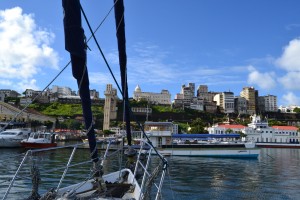
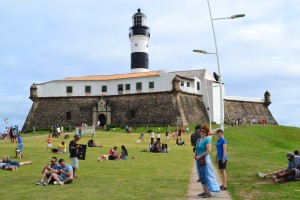
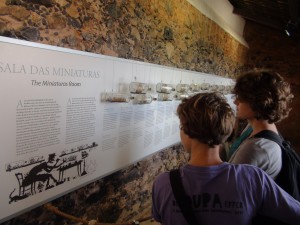
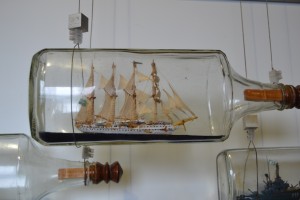
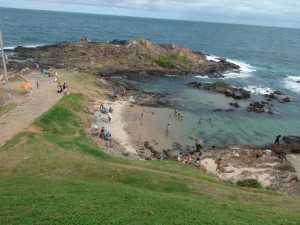
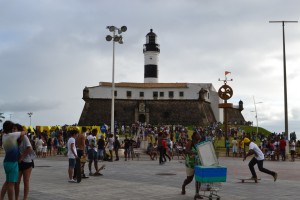
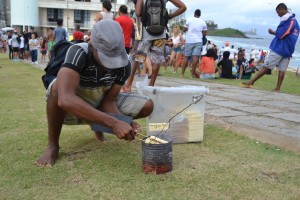
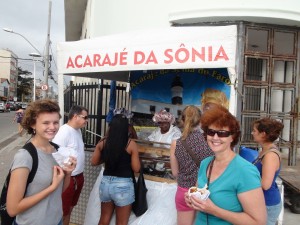
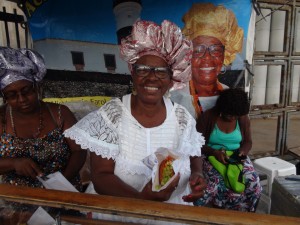

Recent Comments